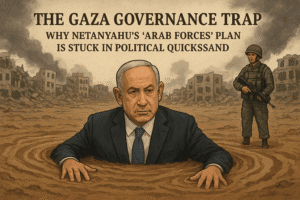The Gaza Governance Trap: Why Netanyahu’s “Arab Forces” Plan Is Stuck in Political Quicksand
Netanyahu’s plan for “Arab forces” to govern Gaza after Hamas collapses under its own contradictions. Arab states demand two non-negotiable conditions: eventual Palestinian Authority control and a pathway to statehood – both red lines for Netanyahu’s coalition. Meanwhile, Hamas insists on retaining its military wing, making its removal impossible. This traps Gaza in deadly limbo: Israel’s proposed reoccupation would be catastrophic, yet its rejection of the PA sabotages the only Arab-backed solution.
With Netanyahu prioritizing political survival and Hamas clinging to power, civilians pay the price through famine and renewed offensives like the planned Gaza City assault. There are no good options left – only varying degrees of failure where leaders’ self-interest overrides 2 million trapped lives. The rubble isn’t just physical; it’s the debris of political courage.

The Gaza Governance Trap: Why Netanyahu’s “Arab Forces” Plan Is Stuck in Political Quicksand
The rubble of Gaza City isn’t just physical debris—it’s the visible collapse of a coherent postwar strategy. Two years after Hamas’ October 7th attacks ignited war, Israel’s cabinet has approved a military advance into Gaza City while rejecting the only internationally backed governance solution. Prime Minister Netanyahu’s proposed handover to unnamed “Arab forces” isn’t just vague; it’s a geopolitical impossibility by design.
The Contradiction at the Core
Netanyahu’s stance embodies three irreconcilable positions:
- Demanding Arab stewardship of Gaza’s reconstruction
- Excluding the Palestinian Authority (PA)—the entity Arab partners insist must ultimately govern
- Refusing Palestinian statehood—the political horizon Arab states require for involvement
This isn’t diplomacy—it’s a circular firing squad. As former Israeli intelligence officer Michael Milshtein notes: “All choices are bad, but occupying Gaza indefinitely would be catastrophic.”
Why Arab States Won’t Play Along
Arab governments signaled willingness to support Gaza’s transition at July’s Saudi-France summit, but with non-negotiable conditions:
- A binding pathway to Palestinian statehood
- PA-led governance after an interim security mission
- Hamas’ complete demilitarization (a concession even Hamas rejects)
Their calculus is clear: No Arab leader will spend $50+ billion rebuilding Gaza or risk soldiers’ lives only to cement Israeli control or legitimize Hamas. As regional analyst Natan Sachs observes: “Netanyahu’s red lines guarantee Arab red lines.”
The Human Cost of Political Paralysis
While leaders debate abstractions, Gaza’s reality deteriorates:
- Aid shortages persist despite airdrops
- 60,000+ dead (per Gaza health officials)
- 2 million displaced facing famine conditions
The planned assault on Gaza City—opposed by Israel’s own security chiefs—offers no strategic victory. Military analysts confirm such operations haven’t broken Hamas in 22 months.
The Unspoken Truth: Survival Over Solution
Both Netanyahu and Hamas cling to positions ensuring their political survival:
- Netanyahu’s coalition collapses if he accepts PA involvement
- Hamas demands retaining its military wing—a deal-breaker for Israel
- Mahmoud Abbas’ PA lacks legitimacy and capacity to govern
This creates a perverse equilibrium: Leaders benefit from perpetual crisis while civilians pay the price.
The Path Forward? Facing “Least Bad” Options
Three scenarios exist—all painful:
- Israeli reoccupation: Militarily draining, morally corrosive, internationally condemned.
- Arab-backed transition: Requires Netanyahu to sacrifice his coalition or Hamas to surrender arms—neither likely.
- Continued fragmentation: Militant enclaves, aid dependency, and cyclical violence.
The rubble of Gaza reflects more than war damage—it mirrors the shattered state of political courage. Until leaders prioritize governance over survival, destruction will outpace diplomacy.
You must be logged in to post a comment.